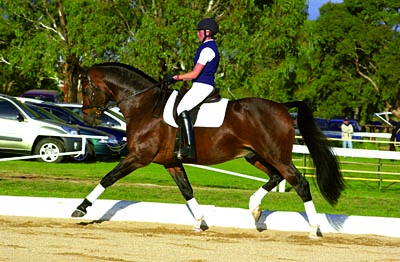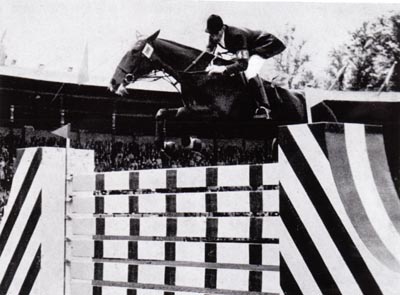Yet MORE Australian Warmblood Studbooks!
In 2002, a bitter factional war erupted in the Hanoverian Society, and when Holger Schmorl was narrowly defeated in an election for President, he showed just how assimilated he had become to the ‘Aussie’ way of doing things, and left to found his own studbook, Studbook Kinnordy – named after his property.
But there were more studbooks in the wings. Another German from a traditional breeding family, Ulrich Klatte joined his Australian born wife, Belinda, on her Belcam Stud in 1984 and soon had a breeding band of just on 70 horses. They imported three stallions initially: Grannus II, Valeur and Jaguar. Later when Valeur was sold to Laurie Connell for Jeff McVean to ride, in 1988, they acquired the horse that was called Aachen in Australia, even though his registered name in Europe, was Azzaro. According to Ulrich in the May 1988 THM:
“There are a lot of useless Warmbloods in Australia! There are some good ones too, but we have to try and upgrade the breed. The first mistake Australians made was to buy old fashioned, big, heavy, clumsy stallions – they were too different from the mares they were bred to, and only produced the odd good foal. A stallion to serve Thoroughbred mares should have some Thoroughbred blood, and be a similar type, not too heavy or clumsy. You can’t put a Draught horse over a Thoroughbred mare and say you’ve got a Warmblood.”
In 1991, Ulrich imported the Contender son, Cavallo, and in 1995, Contango II. Capone was imported in 2000, and Coperit and Hector, the following year.

1992 saw the first of the Belcam Auctions – the first time an auction of young Warmblood horses had been organized in Australia on German lines… complete with the Klatte daughters in German costume and bottles of champagne for the successful bidders. The response was quite good – the first auction produced an average of $9,900 with a top of $26,000.
By 1992, there was some controversy in the AWHA ranks over the pedigree of the colt, Belcam Aalto.
Aalto’s sire was Aachen and his dam, the A grade jumping mare, Espadrille, who was started by South Australian rider, Tad McLean, then campaigned at World Cup level by Chris Chugg. After she retired she was sent to Belcam on a foal and foal about deal…
Chris and his wife, Helen, are keen students of bloodlines and breeding, and it was always their belief that their mare had Clydesdale blood. However when Aalto was branded and issued with a birth certificate from the AWHA in February 1990, he came with a statutory declaration from the mare’s breeders to say that she was straight Thoroughbred, by a Souvenir son, Dolivere out of Sun Rae who was by Landscape and out of Golden Sunshine. And the Klattes expressed their intention of putting the colt up for licensing when he was old enough.
Leaving aside the fact that it seems certain that Souvenir was not a Thoroughbred since the ‘pedigree’ offered by the Koyuna stud where he stood is simply impossible to reconcile with the Thoroughbred studbook (like one ‘stallion’ who is in fact a mare!), Aalto also had problems when you start to investigate Sun Rae’s dam line…
There is no Thoroughbred stallion in the ASB studbook called Landscape whose dates match. However there was a jumping stallion called Landscape who stood in South Australia and was related to Dumbell, one of the first Australian horses to compete in Europe ridden by the late Bert Jacobs.

According to the owner/breeder of Dumbell, Mary Williamson, Blue Bell, a Clydesdale cross was the dam of Dumbell (by Afflatus by Manfred) and her full-brother, Chindit, a hunter for the late Eric Rundle. Bred to the imported Thoroughbred stallion, Landlaw (Fr) she produced Landmark and Landscape and Majimba, an eventer and talented mare, a show hack and Garryowen competitor, Rata. And perhaps that would explain Espadrille’s feathers! Added to that is the fact that Espadrille started life in South Australia, where the Landscape blood is still to be found in jumping pedigrees.
In 1990 in Germany doubts started to be expressed over the parentage of foals ‘by’ the star of the Klatte family stud, Grannus. In 1992 these doubts became public and by 1993 it had been proven that over 40 ‘Grannus’ foals, were not in fact by Grannus – and Ulrich’s brother, Heinich was suspended by the Hanoverian Verband amid what is the major breeding scandal of the post war era.
It was perhaps not the best context in which to launch a new Studbook, especially one that was controlled as a private company by a board of directors, rather than being answerable to a membership, but October 1994 saw the announcement by Ulli and Belinda Klatte of the formation of ACE – the Australian Continental Equestrian Group.
This is from its initial statement of Aims:
“The ACE Group is the first equestrian organization to provide a comprehensive Stud Book to cater for all performance breeds in their various categories. Warmblood horses will be the base of the stud book with other performance breeds well catered for…”
“It is your right to select breeding sires and we will support your choice through full registration available for all stallions, Moreover, negotiations are underway with competent Overseas Horse People to conduct assessments for your breeding and performance stock rather than a selection in your breeding and marketing decisions, and help you to achieve your goal of equalling European Standards.”
Summing up, ACE was to be:
“An accommodating Stud Book operation without the worries of complex breeding guidelines, ‘yes or no’, and miles of rules and regulations.”
Worries about just how accommodating the new book would be, were compounded by the announcement that the first assessor for ACE was to be a German, Dr Roland Samsauer. Dr Ramsauer is undoubtedly one of the world’s experts on Warmblood – particularly Oldenburg – breeding – but he has left the employ of several breeding societies in somewhat clouded circumstances, and several years before his arrival in Australia for ACE, had been the subject of an article in Germany’s Reiter Revue, entitled: ‘Of Olden-Quarters and Unknown-Burgers: A breed society goes West’.
The article reproduced several pedigrees granted to American horses and branded with the Oldenburg crown. One is a filly by the Hanoverian Wendepunkt out of a 2/3s Quarter horse, and the other by the failed KWPN stallion Kinda Lucky out of a mare of unknown breeding. According to the author “these are no isolated cases as serious (American) breeders of Oldenburgers point out. They feel uncertain and angry with the German Oldenburger Verband. The Oldenburger O. varied with a small US, was branded on any rump with four legs that could not run away fast enough.”
The Oldenburg breeding director at the time, Dr Schultze-Schleppinghoff ran for cover: “If those brandings took place it is Dr Ramsauer’s entire responsibility…”
The item in THM provoked a reply from Dr Roland Ramsauer in which he said that the American article was ancient history and that the registrations were only for a foundation book, and that in Australia he had, with Bernd Huslage, the Oldenburg Verband representative, branded ten foals with the Oldenburg brand out of the 120 inspected on the first ACE tour.
The issue of Oldenburg papers was to become an ongoing controversy with some people who passionately wished to believe that their horses were getting ‘real’ German Oldenburg papers. It was certainly hard to get a straight answer from the Oldenburg Verband in Germany. If you asked them there – as I did – was Dr Ramsauer representing the Verband in Australia, they would say ‘NO!’ but if you faxed the same question from Australia, you got a qualified ‘yes’.
Finally the Hanoverian Verband sent a letter to THM in September 2000. It was an official communication from Dr Evelin Vollstedt of the Oldenburg Verband, to Dr Ludwig Christmann of the Hanoverian Verband:
“Following our recent conversation I would like to confirm that the Australian ACE group is not the legitimate representative of the Oldenburg Verband in Australia… Currently there is no legitimate representation of the Oldenburg Verband in Australia. The Oldenburg brand is patented and can only be used by us, or with our consent. In Spring 1999, a few foals were registered by our honorary classifier, Mr Bernd Huslage. The birth certificates have been issued by the Oldenburg Verband.”
Now despite this letter, there was still a vigorous controversy on the THM website forum, with the ‘true believers’ asserting that despite what the Verband director had said, ACE did in fact represent the Oldenburg Verband in Australia, and that horses registered through ACE would be put in the German Oldenburg studbook. There was, the true believers swore, a second letter that would arrive by November 30, 2000 that would make this clear. Finally another letter on Verband letterhead, and the translation, arrived on March 6, 2001. It read:
Dear Mr Klatte,
We respond to your request. The Oldenburger Horse Breeders Association currently provides consulting work to a select number of breeders in Australia. Our consulting work has so far been conducted during the visiting tour organised by the ACE group because this appeared the most convenient way. We continue to see it that way because it allows the Oldenburger Association to rely on some of the group’s logistic resources. We are not planning to make any changes at this point. I hope that I have been able to assist you with this information.
Dr Schulze-Schleppinghoff,
Breeding Manager
Clear now?
The current rules of the ACE organization say that mares in the Main Mare Studbook, ie. with 4 generations of documented breeding (I wonder if there are any Aalto’s in there), with a minimum height of 160 cm, and an average score of 65%+ for conformation and movement, are eligible to be upgraded into the Oldenburger Studbook and its progeny, if the mare is bred to an Oldenburger Approved Stallion, may receive the Oldenburger Brand and Oldenburger Birth Certificate.
ACE has been taken over by Ulrich Klatte’s niece, Alex Wright, who married an Australian, and who is determined to create in Australia a viable studbook for all performance breeders….
“I took ACE on in May 2005, as the previous registrar Birgit Köppler was returning back to Germany. What I see is that a solid system is implemented and it can be taken further.”
“After having two children I thought this is a great opportunity to nicely combine my business administration knowledge gained in other industries with the passion for horses competing gained actively competing for 15 years in Europe”.
“The last two ACE tours I have organized with the long time assessor, Gerhard Thele and first timer to Australia, Gerd Kuest, have proven to be very popular and a great way to bring breeders and independent knowledgeable judges together and also creating a national competition.”
Alex has impressed many people with her sincerity and right now she seems to be a positive force in healing some of the rifts between the various breed organizations and working towards a more rational system:
“The hard thing in Australia is to encourage people to register their horses. Every stud knows their stock but unless you have all numbers, you can’t come up with very meaningful statistics. I have already started communication with AWHA, ISSA, AWSHA and so on, to work under one umbrella and to have all the data running into one system, similar to the ASB and other larger societies – that is the big goal.”
“As I see it, the ACE Group is a consumer-friendly, affordable, service orientated organizaton, where the breeder is acknowledged, creating better competition to bring up the young horses and promoting the Australian Bred Horse Nationally and Internationally. In the future we intend running auctions for members of our Group.”
